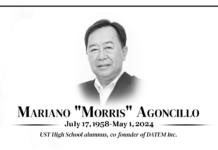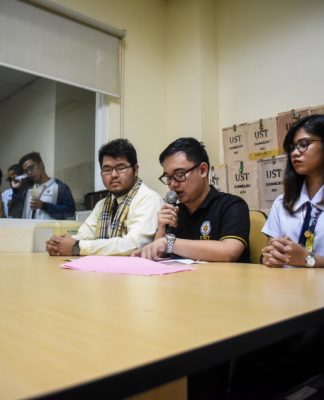a day in the laboratory for two of the country’s top biologists is never complete without “playing” with their samples. Juggling teaching with research work, these Asian Wall Street Journal Young Inventors award laureates uplift quality health by using unconventional technology and simply by having fun in what they are doing.
Dust in the wind
Allergies beware—your days are numbered.
For six years, Prof. John Donnie Ramos, Ph. D. of the College of Science has been developing a diagnostic kit and a potential immunotherapy against the house dust mite, a leading airborne cause of allergic reaction.
His work, “Development of a Diagnostic and Therapeutic Reagent for House Dust Mite Allergy” was the only Filipino finalist in the 2004 Asian Wall Street Journal Young Inventors Award.
Ramos began his research in 1999, when he was doing his dissertation in molecular biology and immunology at the National University of Singapore (NUS).
“I wanted a simple yet feasible research,” Ramos told the Varsitarian. “There is a great interest for house dust mite allergy research since allergy diseases like asthma, and eczema are increasingly being recognized as major health hazards worldwide.”
Ramos isolated the DNA code for allergens from cultured house dust mites. House dust mites belong to the Pyroglyphidae family and are often found in very humid regions.
He used molecular cloning to produce recombinant proteins. The isolated allergens were further used as an immunotherapeutic drug. The diagnostic kit is currently under clinical trial.
According to Ramos, a German manufacturing company is now developing the diagnostic kit using the allergens he identified from the house dust mites. He hopes the kit will be available in the market in two years.
As of now, Ramos is trying to create his own research group. Some of his undergraduate and graduate students are focusing on the other aspects of his house dust mite allergy research.
One group is studying the potential relationship of allergies to parasites like ascaris. Another interesting aspect is the relationship of house dust mite allergy to cockroach allergy.
“There is this theory called hygiene hypothesis, wherein for a certain population allergy cases are low when parasitism is high and vice versa,” Ramos said.
Ramos’ research also won the National Academy of Science and Technology-DuPont Talent Search for Young Scientists award in 2004 and the Best Research Presentation Award in the Second Graduate Students Society of the Faculty of Medicine Science Conference at NUS.
After Ramos finished his Biology degree at the Philippine Normal University, he pursued a master’s degree in Biological Sciences at the UST Graduate School in 1992 and, at the same time, taught at the Biological Sciences Department of the College of Science.
Glow in the “dark”
For someone who is fond of working with little things, this Thomasian prodigy has very big citations to his credit.
Edward Quinto goes to the Thomas Aquinas Research Complex almost every day, extending laboratory hours “playing” with his bacteria samples. From studying a tiny glowing bacterium found in ordinary squids, he invented a simple way to determine the toxicity of water, a scientific breakthrough that earned him the gold medal in the 2001 Asian Wall Street Journal Young Inventors Award.
“The application (of the luminous bacteria) is so basic that it can be done almost anywhere in the world without resorting to expensive equipment,” Quinto said. “These are just very basic tools for determining the quality of the water.”
Quinto said the luminosity of the bacterium is affected by its environment. And if the water is toxic, its glow diminishes.
“If they are exposed to a water medium in which there are harmful compounds like heavy metals, detergents, or pesticides, these bacteria are harmed and their lights will dim,” Quinto said.
With almost 20 years of research experience, Quinto has ventured into other fields, most recently in the development of antibiotics against fungi and yeast growth.
“We go to far-flung areas (to find) new species of streptomycetes bacteria. If the species is new, there is a possibility that the antibiotics produced are also new,” Quinto said. “I’m also trying to produce novel bio-therapeutics from lactobacillus bacteria.”
Quinto said the lactobacillus bacteria can be used to make ear drops or feminine wash, and can also be made into medicine to cure pimples and other skin infections.
Quinto, a 1982 Chemistry graduate of UST, is a living testament to the dictum that great things do come from “small” beginnings.
“Just follow your heart, or where your interest lies. Try really to pursue and make the best out of it. I’m interested with microorganisms. That’s probably why I work well with microorganisms,” Quinto said. “Ultimately, you will reap the fruits of your labors.”














